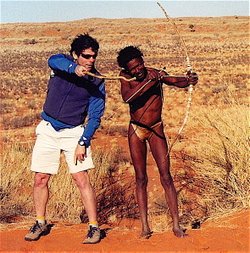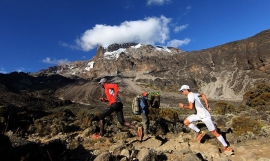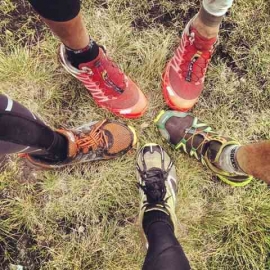Roy M. Wallack is a Los Angeles Times health and fitness columnist and former editor of Triathlete and Bicycle Guide magazines. A life-long runner and participant some of the world’s toughest running and multisport events, including the Boston Marathon and the Badwater UltraMarathon, the Eco-Challenge and Primal Quest adventure races, the Paris-Brest-Paris, TransAlp Challenge, and La Ruta de los Conquistadores road and mountain bike endurance races, and the TransRockies Run, he finished second in the World Fitness Championship in 2004. Wallack is a contributor to Outside, Men’s Journal, Runner’s World, Competitor, Bicycling, Mountain Bike, and many other publications, and the author of The Traveling Cyclist: 20 Worldwide Tours of Discovery (1991) and Bike for Life: How to Ride to 100 (2005), which lays out a plan for athletic longevity through cycling.
Roy M. Wallack 出版书籍合集:
跑步书籍:
Barefoot Running Step by Step_Roy M. Wallack、Barefoot Ken Bob Saxton_2011
自行车书籍:
The Traveling Cyclist_Roy M. Wallack_1991
Bike for Life: How to Ride to 100_Roy M. Wallack_2005
Bike for Life: How to Ride to 100--and Beyond_Roy M. Wallack_2015
其他运动书籍:
Fire Your Gym! Simplified High-Intensity Workouts You Can Do At Home_Roy M. Wallack_2013
Roy M. Wallack once biked from the sea to the summit of a 13,796-ft. Hawaiian volcano in a day, debated persistence hunting with a barefoot Kalahari tribesman in a loincloth, and talked his way out of the gulag when he got caught illegally in the USSR. Now, he's trying to figure out how to run and ride until he's at least 100 years old ("For proof, get back with me in 50 years," he says). A long-time L.A. Times fitness columnist , he's written for many publications (Outside, Bicycling, Runner's World, Competitor, Muscle & Fitness, Consumer's Digest, and more), been an editor (Triathlete, Bicycle Guide), and never turns down an opportunity to do a crazy athletic event he isn't trained for (which is why he's the World's Second-Fittest Man--read on). Roy's got 7 books: his bestseller Bike for Life: How to Ride to 100 (2015, 2005), a cycling-based longevity fitness plan; Fire Your Gym (2013; a 9-week super-fitness program mixing CrossFit and endurance); Barefoot Running Step By Step (2011; best-seller in the minimalist-running genre); Run for Life (2009) -- longevity through running); Be a Better Runner (2011; cutting-edge training tips); and The Traveling Cyclist: 20 Worldwide Tours (1991, Doubleday), which describes his bike trips around the world in the '80s, including the first-ever into the Soviet Union, in 1988.
FITNESS FOR THE LONG RUN -- AND LONG RIDE
As an unremarkable Baby Boomer runner/rider/triathlete/tennis player determined not to slow down, this former collegiate wrestler started researching athletic longevity when he hit 40 -- and struck paydirt. Roy "broke the news" on several important quality-of-life, fitness-performance, and injury-prevention stories that became pillars of his books and common fitness knowledge, including the scary cycling/osteoporosis connection (Bicycling, 2003); the injury-reducing effect of the Pose Method (Runner's World, 2004) and barefoot running (Men's Journal, 2005); the corrective, career-saving potential of postural therapy for runners and other athletes (Competitor, 2001); the untapped economy, power, and knee-friendliness of "butt-centric" pedaling (Bicycling, 2004); and the fountain-of-youth effect of all-out intervals and rapid-contraction weight training (Outside, 2006, and Men's Fitness, 2002), which strengthen the body by initiating release of hormones such as HGH. He was also one of the first to report on Crossfit, the revolutionary, and now-wildly popular high-intensity fitness program (Men's Journal, 2005, and the L.A. Times, 2006), and introduced the groundbreaking concept of a harmful training-zone "Black Hole," discovered by renowned sports researchers Seiler and Esteve-Lanao, in the December 2010 issue of Outside magazine.
Using himself as a "guinea pig" for the training, technique, and nutrition stories he writes, Roy has survived some of the world's toughest endurance events, including the Himalayan 100-Mile Stage (running) Race, the Badwater UltraMarathon, the week-long, round-the-clock Eco-Challenge and Primal Quest adventure races, the 750-mile Paris-Brest-Paris randonnee, and multi-day mountain-bike races such as the Trans-Alp Challenge, BC Bike Race, Trans-Rockies Challenge, Breck Epic, and Costa Rica's La Ruta de los Conquistadores, the latter often labeled "the hardest race on the planet." Despite all that, he says that his greatest physical, mental, and emotional test actually came in 1994, when he rode 800 miles on a tandem bike from Nice to Rome with his earnest but unathletic bride on their honeymoon. The ride resulted, 9 months later, in the birth of a son, now in college, and the future Bike for Life's Chapter 12, a detailed study of the tricky issue of reconciling significant cycling and significant others. In 1999, in the name of science, he ran the Boston Marathon on five days and 34 miles of training while adhering to a radical new forefoot-landing "soft running" technique -- and almost set a new PR. The lessons learned that day in Boston became Chapter 1 of Run for Life.
SECOND-FITTEST AND TRYING HARDER
Finally -- proudly -- Roy is officially the world's "Second Fittest Man," having finished second in the World Fitness Championship in 2004. In fact, it looks like he'll be the second-fittest man for the rest of time, as the event, sort of "an Ironman with iron" that was sanctioned by the Guinness Book of World Records, was disbanded thereafter. Held in a gigantic YMCA in Plano, Texas, it included a 2-mile swim, 10-mile run, 10-mile power hike, 100-mile Lifecycle, 20-mile row, 20-mile elliptical, 500 squat thrusts, sit-ups, and hanging legs lifts, and lifting 500,000 pounds of upper-body weights. He completed it in 21 hours and 59 minutes, putting him a couple time zones behind Rob Powell, the Guinness Book champion, but comfortably ahead of Dan de Jager, a young adventure racer from Sacramento who couldn't swim. Since only these three people (out of hundreds supposedly registered) showed up for the contest, that more or less guaranteed Roy the athletic immortality he'd long dreamed of. ("With great achievement comes great responsibility," he said when it was over, just before collapsing into a deep, 13-hour sleep. Bike for Life and Run for Life soon followed.)
For the full story on Roy's historic Second-Fittest triumph, plus a slide show of 30+ years of his bike-touring around the world (including the first-ever bike ride into the Soviet Union, in 1988), his acclaimed TV appearance with timeless "Brady Bunch" beauty Florence Henderson, and his rousing, poetry-laden induction into the 24 Hours of Adrenalin Solo Hall of Fame, click on the two videos on this page or go to www.bikeforlifebook.com




